Splenomegaly - Study guides, Class notes & Summaries
Looking for the best study guides, study notes and summaries about Splenomegaly? On this page you'll find 2303 study documents about Splenomegaly.
Page 4 out of 2.303 results
Sort by
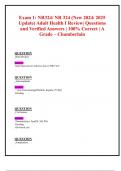
-
Exam 1: NR324/ NR 324 (New 2024/ 2025 Update) Adult Health I Review| Questions and Verified Answers | 100% Correct | A Grade – Chamberlain
- Exam (elaborations) • 23 pages • 2024
- Available in package deal
-
- $10.99
- + learn more
Exam 1: NR324/ NR 324 (New 2024/ 2025 Update) Adult Health I Review| Questions and Verified Answers | 100% Correct | A Grade – Chamberlain QUESTION Beta-blockers heart beats slower with less force (“HR) "lol" QUESTION Anticoagulants Answer: “ clots from forming(Warfarin, heparin, IV/SQ) -bleeding QUESTION Clot busters Answer: Thrombolytics- Tpa(PE, MI, PO) -bleeding -fib=blood clot QUESTION Antiplatelets Answer: ASA, clopidog...
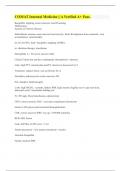
-
COMAT Internal Medicine || A Verified A+ Pass.
- Exam (elaborations) • 74 pages • 2024
- Available in package deal
-
- $15.99
- + learn more
Basophilic stippling correct answers Lead Poisoning Thalasemias Anemia of Chronic Disease Sideroblastic anemia correct answers lead toxicity, Etoh, B6 depletion from isoniazid-- iron accumulation -mitochondria dx: hct 20-30%, lead= basophilic stippling of RBCs tx: chelation therapy; transfusion Hemophilia A + B correct answers XLR Clinical: bleed alot and have arthropathy (hemathrosis->chronic) Labs: high PTT, normal plate and PT, abscent or deceased 8 or 9 Treatment: ...
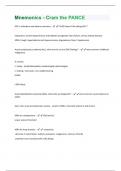
-
Mnemonics - Cram the PANCE Questions And Answers Latest Study Solutions
- Exam (elaborations) • 58 pages • 2024
- Available in package deal
-
- $7.99
- + learn more
ACE-i: indications and adverse reactions - "CHAD doesn't like taking ACE-I" Indications: Control Hypertension and Diabetes (congestive heart failure, chronic kidney disease) ADRs: Cough, Hyperkalemia and Hyperuricemia, Angioedema, Dose 1 hypotension Acute Lymphocytic Leukemia (ALL), what are the s/s and CBC findings? - most common childhood malignancy A: anemic L: lumpy - lymphadenopathy, hepatomegaly, splenomegaly L: limping - bone pain, non-weight bearing FEVER >20% blasts Acut...
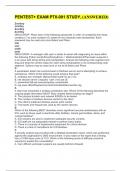
-
Advanced Pathophysiology Week 3 Quiz
- Exam (elaborations) • 38 pages • 2024
-
- $8.49
- + learn more
Advanced Pathophysiology Week 3 Quiz Question 1 2 / 2 pts Clinical manifestations of mild to moderate splenomegaly and hepatomegaly, bronze-colored skin, and cardiac dysrhythmias are indicative of which anemia? Sideroblastic Aplastic You Answered Pernicious Iron deficiency Mild to moderate enlargement of the spleen (splenomegaly) and liver (hepatomegaly) occurs. Occasionally, abnormal skin pigmentation (bronze colored) is seen. Heart rhythm disturbances, along with con...

-
Advanced Pathophysiology Week 3 Quiz
- Exam (elaborations) • 38 pages • 2024
-
- $14.49
- + learn more
Advanced Pathophysiology Week 3 Quiz Question 1 2 / 2 pts Clinical manifestations of mild to moderate splenomegaly and hepatomegaly, bronze-colored skin, and cardiac dysrhythmias are indicative of which anemia? Sideroblastic Aplastic You Answered Pernicious Iron deficiency Mild to moderate enlargement of the spleen (splenomegaly) and liver (hepatomegaly) occurs. Occasionally, abnormal skin pigmentation (bronze colored) is seen. Heart rhythm disturbances, along with con...

-
Advanced Pathophysiology Week 3 Quiz- Version 3
- Exam (elaborations) • 25 pages • 2024
-
- $14.49
- + learn more
Advanced Pathophysiology Week 3 Quiz- Version 3 Question 1 0 / 2 pts Clinical manifestations of mild to moderate splenomegaly and hepatomegaly, bronze-colored skin, and cardiac dysrhythmias are indicative of which anemia? Correct Answer Sideroblastic Pernicious You Answered Iron deficiency Aplastic Mild to moderate enlargement of the spleen (splenomegaly) and liver (hepatomegaly) occurs. Occasionally, abnormal skin pigmentation (bronze colored) is seen. Heart rhythm d...
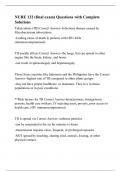
-
NURE 132 (final exam) Questions with Complete Solutions
- Exam (elaborations) • 12 pages • 2024
-
- $15.49
- + learn more
Tuberculosis (TB) Correct Answer--Infectious disease caused by Mycobacterium tuberculosis -Leading cause of death in patients with HIV/AIDs (immunocompromised) TB usually affects Correct Answer--the lungs, but can spread to other organs like the brain, kidney, and bones -can result in splenomegaly and hepatomegaly Those from countries like Indonesia and the Philippines have the Correct Answer--highest rate of TB compared to other ethnic groups -may not have proper healthcare, or insu...
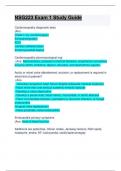
-
NSG223 Exam 1 Study Guide : 100% Verified: Guaranteed A+ Score Guide: Latest Updated
- Exam (elaborations) • 13 pages • 2024
- Available in package deal
-
- $7.99
- + learn more
Cardiomyopathy diagnostic tests (Ans- Chest x-ray (cardiomegaly) Echocardiography ECG Cardiac catheterization Endomyocardial biopsy Cardiomyopathy pharmacological mgt (Ans- beta blockers; potassium channel blockers, angiotensin-converting enzyme (ACE) inhibitors; digoxin, diuretics, and dysrhythmic agents. Aortic or mitral valve débridement, excision, or replacement is required in what kind of patients? (Ans- - Develop congestive heart failure despite adequate medical treatm...

-
Advanced Pathophysiology Week 3 Quiz- Version 3
- Exam (elaborations) • 25 pages • 2024
-
- $14.49
- + learn more
Advanced Pathophysiology Week 3 Quiz- Version 3 Question 1 0 / 2 pts Clinical manifestations of mild to moderate splenomegaly and hepatomegaly, bronze-colored skin, and cardiac dysrhythmias are indicative of which anemia? Correct Answer Sideroblastic Pernicious You Answered Iron deficiency Aplastic Mild to moderate enlargement of the spleen (splenomegaly) and liver (hepatomegaly) occurs. Occasionally, abnormal skin pigmentation (bronze colored) is seen. Heart rhythm d...
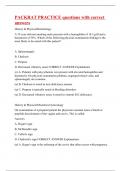
-
PACKRAT PRACTICE questions with correct answers
- Exam (elaborations) • 791 pages • 2023
- Available in package deal
-
- $15.49
- + learn more
History & Physical/Hematology A 55-year-old non-smoking male presents with a hemoglobin of 18.5 g/dl and a hematocrit of 56%. Which of the following physical examination findings is the most likely to be noted with this patient? A. Splenomegaly B. Cheilosis C. Purpura D. Decreased vibratory sense CORRECT ANSWER Explanations (c) A. Patients with polycythemia vera present with elevated hemoglobin and hematocrit. On physical examination plethora, engorged retinal veins, and splenomegaly are...

$6.50 for your textbook summary multiplied by 100 fellow students... Do the math: that's a lot of money! Don't be a thief of your own wallet and start uploading yours now. Discover all about earning on Stuvia


